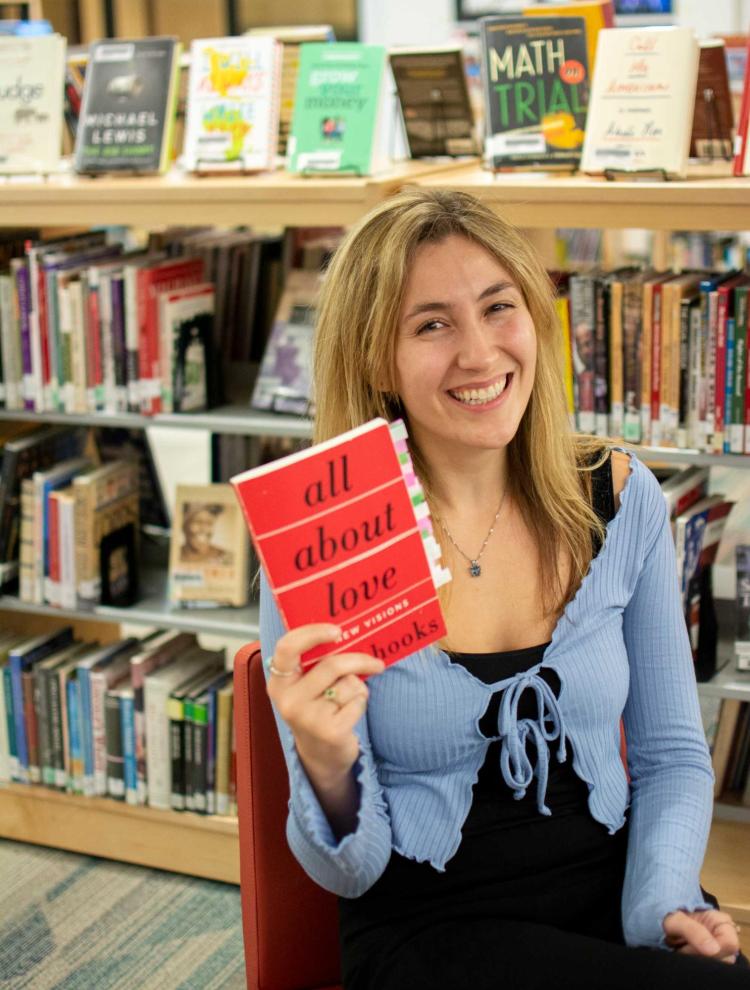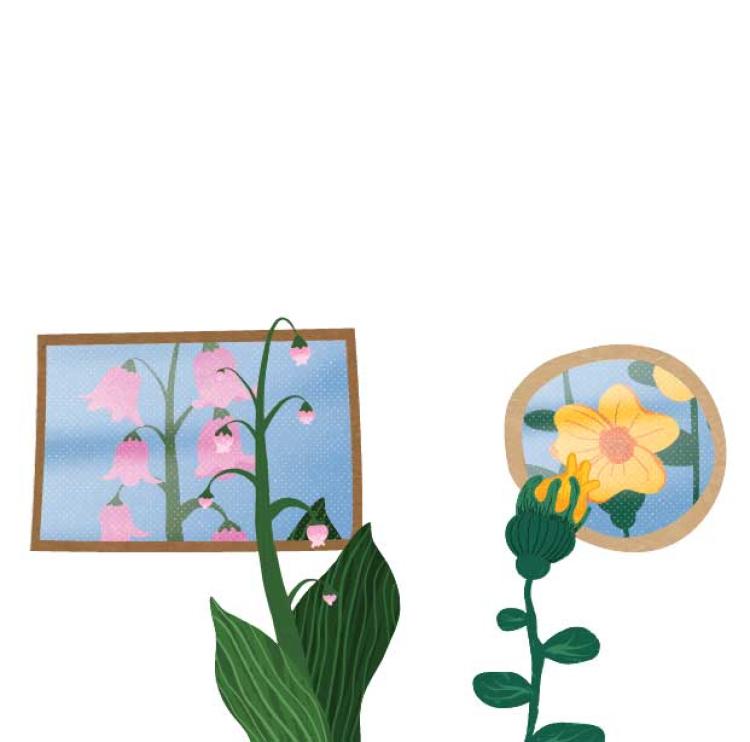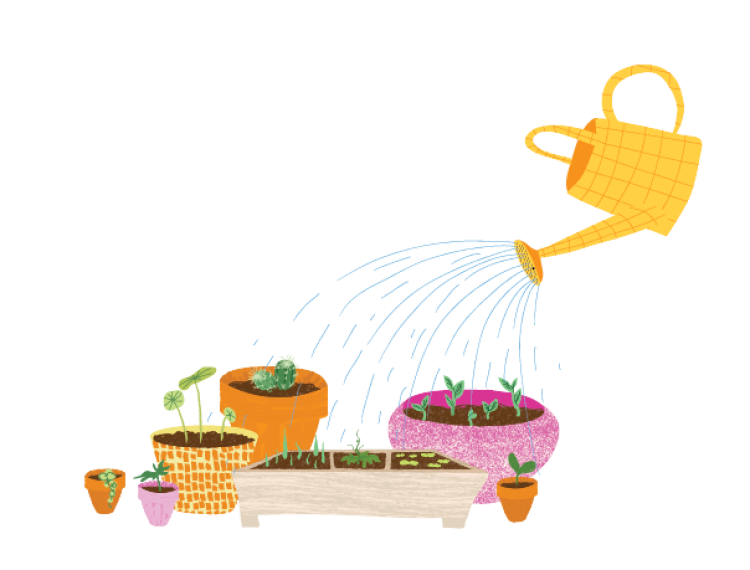Opening Worlds

“I’m really excited,” she said. “I just get nervous that I’m not going to be a good teacher, but I know that I have a huge community to fall back on that makes me feel secure.”
That sounds like the typical mix of emotions for a newly minted teacher, but in some ways, these are atypical times with mounting pressures on schools and educators— including unprecedented calls to ban diverse books, and school board meetings full of parents or outsiders attempting to control curricula they deem “too radical.”
Ktsanes (MEdu’22) is not put off by recent challenges. She is excited to build relationships with students and introduce her new unit on love. She read All About Love by bell hooks after reading many other inspiring works by hooks in the CU Boulder Master’s Plus Teacher Licensure program, where students gain a master’s degree, classroom experience and teacher licensure in one year. Ktsanes knew she needed to share the book with students.
As part of the set curriculum, her students must read The Great Gatsby, F. Scott Fitzgerald’s classic book about social class. Ktsanes says the book is ripe with negative views of love, the perfect transition to All About Love and her unit exploring different forms of love from the students’ perspectives.
“Sometimes love is viewed as soft or too feminine to be taken seriously,” she said. “But I think bringing something that is vital to your life experience as a unit in school is really important for kids.
Books as windows, mirr

Ktsanes believes books and authors such as hooks, a Black activist known for her works on education, race, gender and sexuality, open up new worlds for readers like her and her students.
She learned about the concept of books as windows, mirrors and sliding glass doors in a CU Boulder class with Stephanie Toliver, assistant professor of literacy studies.
The concept was developed by children’s literature researcher Rudine Sims Bishop in the 1990s. Stories can be mirrors reflecting lived experiences, windows into the experiences of people whose identities differ from those of readers, or sliding glass doors where readers enter different worlds.
“I am white, and I often saw mirrors in media and popular culture growing up,” Ktsanes said. “It’s so important for all students to be able to see mirrors in books, but it’s also important for students to get windows and sliding glass doors as well, where they can step into another experience and be transformed.”
Toliver, who studies Black girlhood and speculative storytelling, took the mirrorswindows-doors concept a step further to describe books as telescopes, where books tap into imagination, futurity and the fantastic.
“If we have a book that acts as our telescope, it gathers light, it gathers joy from faraway places and puts it into the pages of the text, so that we can read it and experience it,” Toliver said.
“It’s not just one telescope. I was thinking about observatories, where you can see all these celestial bodies and different stars, and I thought, ‘Our classroom(s) should be these observatories where we see speculative stories from all different cultures and experiences.’”
From an early age, Toliver loved reading and futuristic storytelling. Today, she focuses almost exclusively on science fiction and fantasy young adult novels—besides academic texts. Toliver is troubled by the notion that science fiction and other genres are considered stepping stones to reading “real literature.”
“If you’ve ever read sci-fi or fantasy texts, you know you have to learn new languages and envision new worlds. You have to imagine them,” she said. “That’s difficult, but it’s not considered to be difficult. It’s considered to be that ‘fun’ thing that people do on their way up to the ‘real’ stuff.”
As a former high school teacher in Florida and the only Black teacher in the English department, Toliver found required reading lists narrow and limiting. She would supplement readings with sci-fi short stories and alternative formats, like graphic novel versions of Romeo and Juliet, and watch her students come alive when they could choose their books.
Beyond the canon
Wendy Glenn, professor of literacy studies, has also seen the benefits of moving beyond the required school reading canon. Teachers do not need to abandon classic texts, but rather expand reading possibilities to other titles and allow readers to decide what stories resonate with them.
“If our aim is to encourage young people to read and to see themselves as readers, we as teachers need to be more open to the kinds of texts that we count as worthwhile,” she said.
“Texts written by Shakespeare or Faulkner or Steinbeck can serve as powerful teaching texts. But if young people are fed a steady diet of only those texts, they are missing out on titles that can enrich and provide nutrients that might help them grow in different ways.”
Glenn has examined the difference between school readings, or prescribed texts, and reading in school, or less prescribed open options.
“There are so many beautiful stories available to readers,” she said. “As educators, we must be aware of what’s out there, so we can offer suggestions but also be open to what different students might gravitate toward.”
Making space for expansive reading options might feel daunting for teachers as banned book lists grow and grab headlines.
The American Library Association (ALA) reported unprecedented attempts to ban books in 2021. There were more than 700 challenges to library, school and university materials resulting in 1,597 individual books challenged or removed, and most of the besieged books were written by or about Black or LGBTQ people. Books such as young adult standout The Hate U Give by Angie Thomas and Toni Morrison’s The Bluest Eye were on the ALA’s 10 most challenged book lists in 2020 and 2021, but CU Boulder researchers argue these contested books matter for readers and teachers.
Representation matters
Adam Crawley was a master’s student in his early 30s when he first read a children’s book that mirrored his sexuality, And Tango Makes Three, a frequently challenged book about two male penguins raising a chick together at New York’s Central Park Zoo.
“That was really powerful for me, and I wondered, 'Where have these books been all my life?’” he said, while also acknowledging his white, cisgender identities have been mirrored in many books.
“That got me interested in exploring what LGBTQ-inclusive books exist and how are they being used in classrooms, and that’s where I started with my inquiry during my PhD studies.”
Crawley, who joined CU Boulder as an assistant teaching professor of literacy studies this fall, examines stakeholders’ responses to LGBTQ-inclusive texts in elementary contexts. His dissertation was focused on parents who identify as straight allies of LGBTQ people. Choosing that subgroup was intentional.
“As an elementary teacher, I felt very vulnerable about having these books in my classroom because of my own identity, and I don't think I paid enough credence to the fact that ally parents exist,” he said. “Yes, some parents might have opposed these books or their use in my classroom, but there were also parents who would have spoken up and had my back. I wanted to tap into those voices.”
Crawley grew up in Georgia and has taught in his home state, Oklahoma and Texas. “Part and parcel to the work I do is thinking about how there are teachers doing this work in politically contentious areas and still making it happen,” he said.
Crawley has observed how teachers can build coalitions of like-minded peers, parents and professional organizations to problem solve together and feel supported.
Finding hope and joy in the rebellion

For that same reason, Sara Staley and Bethy Leonardi, co-founders of A Queer Endeavor, established the Queer Educator Collective for LGBTQ teachers to carve out social time to support one another.
Staley, an assistant professor, and Leonardi, an associate professor, have studied the complicated work of preparing preservice teachers to teach gender and sexual diversity education, and the power of leaning into the discomfort that ensues. Recently, they have also been looking at ways to counter the emotional crises that educators experience.
“We’ve been reminding ourselves of the joy in teaching, the community, the solidarity and the people that you can lean on,” Staley said. “It’s been so hard to be a classroom teacher. How can we lift up the joy in it, because that’s really important for the novice teachers and for the people who have been in it for a long time.”
Staley implemented a “joy bank” in her classroom for prospective teachers entering the field where students could make deposits and share stories—from a thank you note left on a teacher’s white board to an emotional poem by a nonbinary student.
“It’s a reminder that this work is about human beings and our capacity to care for one another,” she said.
CU Boulder faculty see hope in the ways that teachers, particularly the preservice teachers they work with, prioritize the joy in teaching and push back on outside challenges. Glenn pointed out that educators facing opposition from some parents, guardians and politicians is not new.
“This idea that other people can decide what’s best for the classroom is a perennial issue,” she said.
“But people who have decisionmaking power don’t always know schools, classrooms or teachers, and the beauty and complexity of the work, and they also don’t always know kids.
“It’s frustrating when adults don’t trust young people to grapple with complexity, especially as we think about young people as the next generation of decision-makers.”
Glenn has also witnessed unprecedented anxiety from preservice teachers entering the field. However, she has faith in the students like Ktsanes, who seek support networks and introduce lessons and texts that engage young people in the world’s beauty and intricacies.
“I think teaching is in many ways a subversive profession,” she said. “There have always been people who’ve been trying to hold teachers under their thumb, and good teachers know how to do the good work that they want to do with young people despite that.
“I find hope in that rebellion.”

